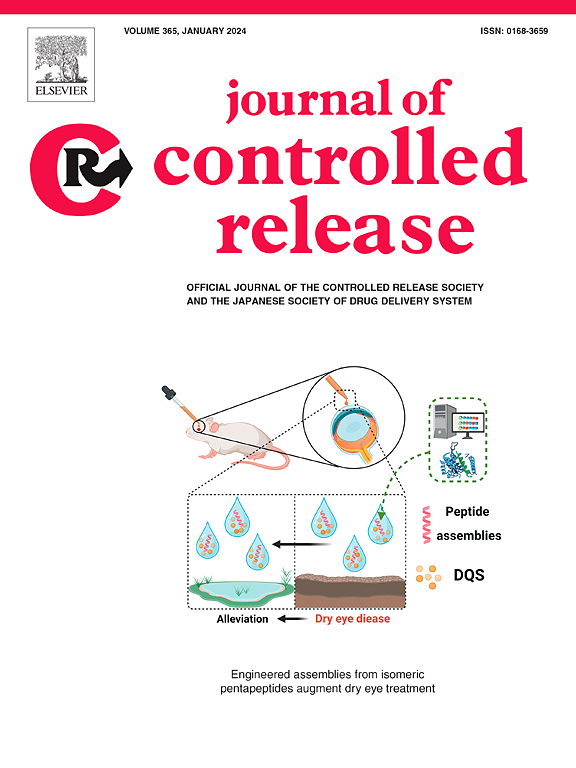一种新型阳离子脂质体配制的toll样受体(TLR)7/8激动剂增强了芬太尼毒性疫苗的效力
IF 10.5
1区 医学
Q1 CHEMISTRY, MULTIDISCIPLINARY
引用次数: 0
摘要
美国阿片类药物流行是一场非同寻常的公共卫生危机,始于1990年,并在过去十年中显著加速。自2020年以来,每年有超过10万例致命药物过量的报告,其中75% %涉及芬太尼及其类似物(F/FA)。需要加快转化创新、有效和安全的治疗方法,以加强现有措施,应对这一危机。针对F/FA和其他阿片类药物的主动免疫是一种有希望的治疗和预防阿片类药物使用障碍(OUD)和阿片类药物引起的过量毒性的策略。先前,我们证明了抗芬太尼疫苗包含芬太尼半抗原(F)与白白病交叉反应物质(CRM)结合,与吸附在Alhydrogel®(明胶)上的新型脂化toll样受体7/8 (TLR7/8)激动剂ni- 4001混合,诱导高亲和力芬太尼特异性多克隆抗体,保护小鼠,大鼠和迷你猪免受芬太尼诱导的药理作用。本研究将ni -4001配制成具有不同表面电荷的脂质体,探讨其对F-CRM吸附、ni -4001佐剂性和疫苗效力的影响。此外,由于先天免疫在介导成瘾疫苗疗效中的作用在很大程度上是未知的,我们在体外测试了这些配方对先天免疫的激活。阳离子ni -4001脂质体优于其他脂质体和铝基制剂,可增强芬太尼疫苗的功效,并通过阻断芬太尼向大脑的分布,保护大鼠免受心动过缓和呼吸抑制。芬太尼疫苗在小鼠树突状细胞系(JAWS II)中,无论是用阳离子型的ni -4001脂体佐剂,还是用吸附在明质上的ni -4001水溶液佐剂,都能显著诱导共刺激分子和成熟标志物的表面表达,而前者在增强巨噬细胞表面CD40、CD86和诱导型一氧化氮合酶(iNOS)的表达方面更有优势,这表明了细胞的成熟和活化。这些结果支持进一步研究基于脂质体的TLR7/8激动剂制剂,以提高针对F/FA和其他公共卫生利益的阿片类药物的疫苗的效力。本文章由计算机程序翻译,如有差异,请以英文原文为准。

A novel cationic liposome-formulated toll like receptor (TLR) 7/8 agonist enhances the efficacy of a vaccine against fentanyl toxicity
The U.S. opioid epidemic is an extraordinary public health crisis that started in 1990 and significantly accelerated in the last decade. Since 2020, over 100,000 fatal drug overdoses have been reported annually, and 75% of those involved fentanyl and its analogs (F/FA). Accelerating the translation of innovative, effective, and safe treatments is needed to augment existing measures to counteract such a crisis. Active immunization against F/FA and other opioids represents a promising therapeutic and prophylactic strategy for opioid use disorder (OUD) and opioid-induced overdose toxicity. Previously we demonstrated that a vaccine against F/FA comprising a fentanyl-based hapten (F) conjugated to the diphtheria cross-reactive material (CRM), admixed with the novel lipidated toll-like receptor 7/8 (TLR7/8) agonist INI-4001 adsorbed on Alhydrogel® (alum) induced high-affinity fentanyl-specific polyclonal antibodies that protected against fentanyl-induced pharmacological effects in mice, rats, and mini-pigs. Here, INI-4001 was formulated into liposomes with different surface charges, and their impact on F-CRM adsorption, INI-4001 adjuvanticity, and vaccine efficacy were explored. Additionally, as the role of innate immunity in mediating the efficacy of addiction vaccines is largely unknown, we tested these formulations on the activation of innate immunity in vitro. Cationic INI-4001 liposomes surpassed other liposomal and aluminum-based formulations of INI-4001 by enhancing the efficacy of fentanyl vaccines and protecting rats against bradycardia and respiratory depression by blocking the distribution of fentanyl to the brain. Fentanyl vaccines adjuvanted with either cationic INI-4001 liposomes or the aqueous INI-4001 adsorbed to alum induced significant surface expression of co-stimulatory molecules and maturation markers in a murine dendritic cell line (JAWS II), while the former was superior in enhancing the macrophages surface expression of CD40, CD86 and inducible nitric oxide synthase (iNOS), indicative of maturation and activation. These results warrant further investigation of liposome-based formulations of TLR7/8 agonists for improving the efficacy of vaccines targeting F/FA and other drug targets of public health interest.
求助全文
通过发布文献求助,成功后即可免费获取论文全文。
去求助
来源期刊

Journal of Controlled Release
医学-化学综合
CiteScore
18.50
自引率
5.60%
发文量
700
审稿时长
39 days
期刊介绍:
The Journal of Controlled Release (JCR) proudly serves as the Official Journal of the Controlled Release Society and the Japan Society of Drug Delivery System.
Dedicated to the broad field of delivery science and technology, JCR publishes high-quality research articles covering drug delivery systems and all facets of formulations. This includes the physicochemical and biological properties of drugs, design and characterization of dosage forms, release mechanisms, in vivo testing, and formulation research and development across pharmaceutical, diagnostic, agricultural, environmental, cosmetic, and food industries.
Priority is given to manuscripts that contribute to the fundamental understanding of principles or demonstrate the advantages of novel technologies in terms of safety and efficacy over current clinical standards. JCR strives to be a leading platform for advancements in delivery science and technology.
 求助内容:
求助内容: 应助结果提醒方式:
应助结果提醒方式:


